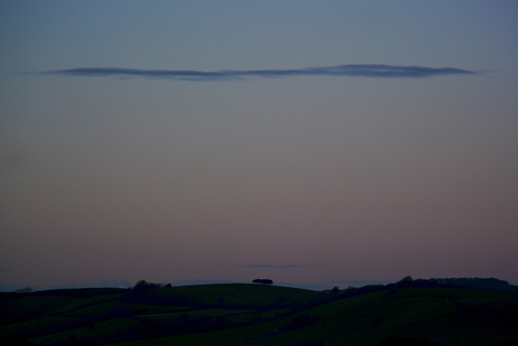by Neil Sentance.
The bell for last orders was clanging. Nick and I drained the last of our whisky nightcaps, and stepped out of the Anchor Inn. Already outside was our friend Gabriel, smoking a last roll-up and gazing north at a conflagration in the sky. ‘Bridport on fire?’, a dog-walker said. No – it was the half-moon, a fiery semi-discus rising through the blue-black sky. We knew now we would have our path lit in front of us, over the cliff tops back to the campsite at Downhouse Farm, nestled in the folds of Eype Down, a few hundred yards behind the South West Coast Path. . .
It was the last camping trip of the year, before the winter brings in the storms, the swirling sea frets and the thronging cold. We had hiked over to the pub at Seatown in the late afternoon, the sun setting over the cliffs at Lyme Regis and suffusing the way ahead with an autumnal half-light that washed out the landscape into petering, deadbeat tones. The day had been bright and clear and the seaward view lucent: to the east, Portland Bill lighthouse, prominent on its outcrop, rising over tidal races and shallow reefs; to the west, the honeycombed red sandstones of East Devon; and in between, the rippling vastness of Lyme Bay. Late-staying martins had burst out of the cliff over Doghouse Hill, screeching shrill invective as they flitted through the air, feasting on evening gnats, the long journey south soon to be upon them. It was here that archaeologists recently found evidence of West Dorset’s oldest human settlement: ancient pottery, impressed by fingernails of 10,000 years ago, from human deep-time. Coastal erosion means the site will soon disappear into the sea, historical time eclipsed by the antiquity of the local geology. Soon, the whitewashed face of the pub had appeared in the distance, barnacled under Golden Cap, the highest point on the Jurassic Coast and the entire south coast of Britain. After a fish-and-chips dinner, we had sat out in the cliff-edge garden, sipping Copper Ale, and contemplating the waning afterglow on the shore below.
Now, with sky stripped of daylight, it was time for the long march home. Striding back up Doghouse, the sky was set with the constellations; moonlight traced out the land and sea. We settled into Indian file, Nick path-finding, well-shod and confident in the way ahead. I followed, in decades-old tread-worn trainers, forcing me to mince, slip and slide in his footsteps, eyes fixed ahead on his lit cigarette end, a mini-beacon. Gabriel brought up the rear, sometimes distracted and falling off the pace. The going was hard, with full bellies and knackered knees, until we crested the ridge at 420 feet. The sea lapped at the rock face long below. Behind us, we could see the street lamps of Lyme. Ahead, beyond Portland, was the neon glow of Weymouth partying on a Saturday night. . .
We trudged on, and became aware of a greater hazard in the dark – livestock. A few Badger-Faced Welsh Mountain sheep dotted the fields to the edge of the track, pale monoliths, eerie and static. And as we approached the crags over East Ebb Cove, we made out the bulky outlines of recumbent cattle, clumped in small herds, snorting, and slowly re-masticating the day’s grazing. We didn’t want to freak them into stampeding, like the shepherd Gabriel Oak in Hardy’s Far From the Madding Crowd, his flock lost over the cliff-edge, maybe this one. Cautiously we advanced, cooing softly to herald our arrival, stifling laughter as we skated through the cow shit.
We temporarily lost the moon under the overhanging hillside and it was colder when we climbed the 515 feet up to Thorncombe Beacon. We rested by the wooden fence and looked out over the Bronze Age tumulus. In a copse of alders a magpie rattled. An occasional car roared on the unsighted coast road a few miles north. Sheep farted. Otherwise, just the sound of the sea, the limitless, intractable sea. The prehistoric hill forts that loom over the Marshwood Vale had become dimly shaped mounds, sunken into the deep dark earth. A lone cloud out to sea resembled a monstrous barn owl ghosting over the horizon. Past the thorn trees, shaped by wind-topiary, the fairy lights of inshore fishing boats and beach anglers winked on the littoral. In the shadows beyond the cliff fence, a parallel path steeply switch-backed down out of sight, abysmal, bottomless. We moved off, cleaving to the visible track, skirting round the hill, and walked alongside spiny barricades of gorse, the path pitted with rabbit holes.
We made it back to the Downhouse farm campsite, and unwilling yet to turn in, sat out drinking beer, reflective, even a little stunned. We stared out over a field of sheep, the herd shoaling like mackerel when flushed by a noise. Pigs snuffled, ignoring the farm dog; night birds rustled in the spinney. In the morning, before breakfast at the excellent Garden Café, we retraced our steps in filtered sunlight back up to the beacon but the night-time magic had dissipated into daytime soft-focus.
That nightwalk will stay unweathered in our minds, its memory as sustenance, laid down for the winter ahead.
